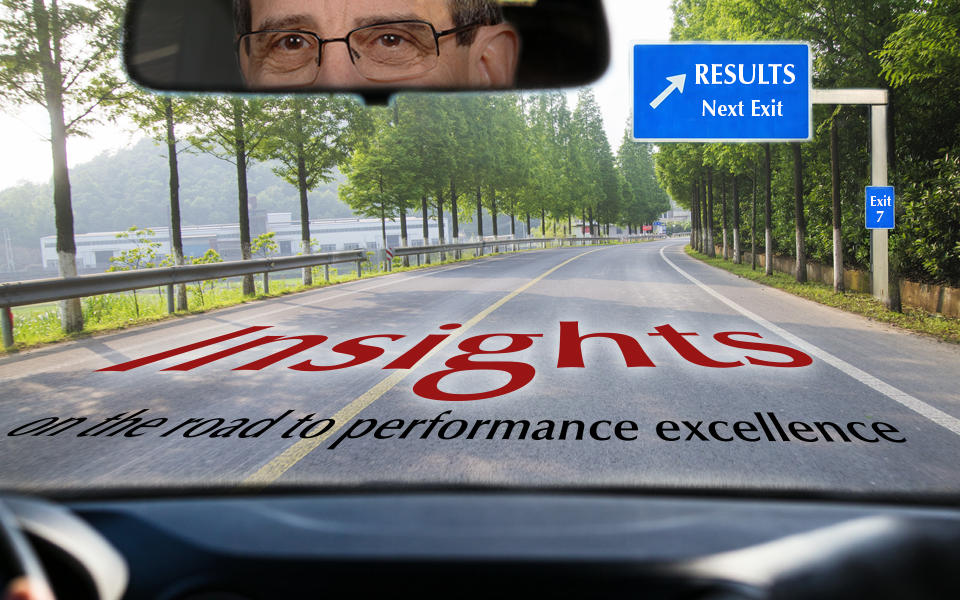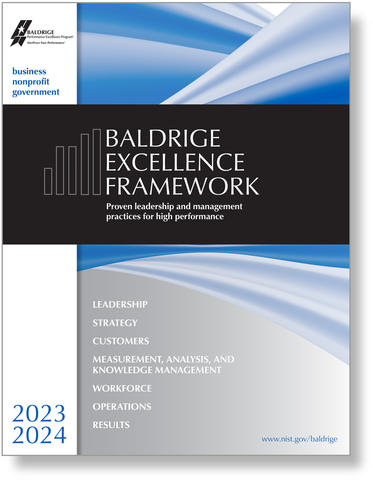Blogrige
The Official Baldrige Blog

Who cares about succession planning? As an organization or an aspiring senior leader, you need to care. Proper succession planning by an organization and its senior leaders is one of the keys to organizational resilience and long-term success. I know this to be true from many Baldrige Award-winning organizations that have done effective succession planning and continued to thrive through generations of leaders.
I also know this to be true from personal experience with high-performing organizations that have not prepared a next generation of leaders or abandoned those leaders when it came time for CEO succession. Frequently those "outside" leaders assumed that the old leadership and organizational performance systems were bad, the organizations stumbled, and sometimes they never recovered. Their high-performing organizational cultures were destroyed. In two instances, with Fortune 500 companies, the former CEOs were brought back to rescue the organization.
These lessons from history resulted in us placing a heightened focus on succession planning and leadership development in the Baldrige Excellence Framework®, where these topics are addressed in item 1.1 on Senior Leadership and item 5.2 on Workforce Engagement.
Let me share some relevant data about CEO success and succession, in case you are unconvinced (or to support the conviction of those who are convinced). I will then discuss how organizations can best prepare for senior leader succession and how rising leaders can prepare themselves for a senior leadership role.
The Data
According to the Center for Creative Leadership, almost half of all CEOs fail, and companies struggle with short-term chief executives because of a lack of preparation for the job. In a McKinsey study that interviewed 67 outstanding CEOs, more than two-thirds said that, in hindsight, they were unprepared for the job. Furthermore, more than 30% of CEOs don't make it past three years in their positions, according to this January 2024 study.
According to an American Management Association survey of 1098 senior managers and executives, reported by Forbes, only about 8% of companies have a comprehensive leadership development program as part of their business plan and about 25% do no succession planning at all.
Finally, according to Vik Malhotra, former chair of McKinsey's Americas region, 80% of successful CEOs come from within their companies. So it behooves companies to prepare these potential senior leaders as thoroughly as possible.

Organizational Succession Planning
Forbes sought advice from experts on how organizations can groom successors and plan for an orderly transition of leadership. The following guidelines build on the Forbes' recommendations.
- Have a clear set of business goals.
A clear set of goals allows the organization to identify the skills and competencies that will be needed to achieve its strategy. Using business criteria to identify needed skills and competencies helps to depersonalize succession planning and focus on the task, not individual "chosen" people. - Seek employees who could fit the business needs.
If there are potential candidates internally, develop the added skills and depth they need. If no internal individuals can be identified, hire some individuals with the right potential and let them learn your culture and business strategy while developing their skills and before making a decision about succession. - Communicate with potential future leaders.
Let people know that they are your potential future leaders. This information is both motivational and effective in enhancing dialogue about their strengths and opportunities for focus in their ongoing development. - Encourage healthy competition.
Some competition among potential leaders is healthy and can test their skills, including their ability to function with a leadership team. Avoid fostering a "race to the top," which can drive valuable leadership talent to leave the organization rather than serve in non-CEO leadership capacities. Be careful to conduct the competition within the culture of the organization. - Create a supportive learning environment.
Learning should be supported and encouraged for all employees. The opportunity to learn is a significant motivator and engagement factor for employees and can reduce turnover. And you can't predict who will emerge as your next generation of leaders. - Always be prepared for the unexpected.
The need to transition to a new leader may occur unexpectedly. Offer potential candidates a firm grasp of what senior leadership will be like. They should be offered opportunities to work on difficult challenges with the current CEO.
Personal Development
In addition to my personal knowledge gained through reading business literature and research, knowledge of Baldrige Award winners and Baldrige Executive Fellows, and my personal journey through leadership, I found three articles particularly helpful in preparing this personal development section: The Ever-Ending Journey of a CEO: Path to Becoming an Effective Leader, in CEO Outlook Magazine; How to Become a CEO: Keys to Reaching the C-Suite, from the Center for Creative Leadership; and, How to Prepare for the CEO Role, from McKinsey & Company.
I have divided this section into two parts, the first on traits you need to have or acquire and the second on activities to benefit your development.
Traits You Need
- Personal Characteristics
Potential leaders must be ethical and transparent, displaying high integrity. They need to demonstrate these characteristics through their actions at work and in their private lives. They genuinely care for their colleagues at all levels of the organization and for their customers and community. They are open to new and differing ideas. They are comfortable with being in the spotlight and public speaking. - Strategic Thinking
Strategic thinking involves the ability to analyze data and situations, synthesize the information, and draw larger organizational conclusions. Potential leaders must be capable of setting a bold vision for themselves and their organization. They must be able to translate that vision into an executable strategy that their colleagues support. They must be able to think like an outsider, objectively assessing their organization. - Resilience
Potential leaders must be personally and organizationally resilient. They respond to adversity and adapt to unforeseen events and opportunities. They study the environment to anticipate potential challenges. When challenged, they not only bounce back, but they actually bounce forward. They are willing to embark on a transformative journey that leads the organization to new heights and into new territory. - Self-Awareness
Potential leaders should understand their personal strengths and weaknesses. They build a team of complementary colleagues who compensate for their weaknesses. They seek input from others and are open to adopting their ideas. - Feedback Readiness
Successful leaders have honed their active listening skills. They seek and are willing to accept constructive feedback and act on it appropriately. They also give constructive feedback to colleagues and subordinates, supporting their colleagues' personal growth. They are effective at conflict resolution and conflict de-escalation. - Commitment
Potential leaders need to ask themselves if they are only seeking the recognition of becoming the senior leader or if they are committed to the intense effort of being that leader. Senior leadership is frequently described as a 24/7, all-consuming commitment. Are you interested in making that commitment?
Developmental Actions
- Excel at Your Current Job.
Mediocre performers are not prime candidates for higher levels of leadership. Focus on excellence in your current job. Be an effective leader of your current unit or team. Build a team culture that inspires collaboration and success. Instill a sense of purpose within your team. Set important and challenging goals for your team and encourage innovation. Develop your subordinates, so that they can grow. Empower your teammates to act within the values and mission of your organization to achieve your agreed-upon goals. - Assess Your Current Abilities.
Objectively assess your current strengths and opportunities for improvement. Set a vision for your career growth. Enlist the help of supportive colleagues in achieving that vision. Seek assignments that will address your opportunities for improvement. - Learn from Predecessors.
Ask supportive current and former leaders how they address the challenges and stresses of the job. Learn from their actions and behaviors. Ask them for guidance in your development. - Seek and Be a Mentor.
A mentor can help you build your capabilities and address your challenges. Seek a personal role model who exhibits attributes that you admire and ask if they could be a mentor to support your growth. Also, be available to mentor colleagues who are looking to develop their careers. Simultaneously, you will benefit from the questions they ask. - Seek Diverse Perspectives.
You can gain significant insights from people who have had different life experiences and cultural, educational, and career paths than yours. They can provide perspectives that you might not consider from your vantage point. They can broaden your thinking and your vision. - Study the External Environment.
The external business, social, technological, and political environments are constantly evolving. Be a student of change. Predict the impact of the changing environment on yourself, your organization, and your industry. - Broaden Your Experience Base.
Senior leaders have a breadth and depth of capabilities, networks, and experiences. Fill gaps in your experience. Seek assignments that give you P&L (budget) responsibility and functional exposure outside your area of expertise (e.g., customer-facing, supply network, and cross-business assignments). Get involved in outside, industry-wide committees. Serve on a community organization's board to gain governance experience.
A Challenge
What is your organization doing to ensure its sustainability and ability to not only survive but also thrive in the future? Is your organization prepared for a smooth transition of leadership? Is it prepared for an unexpected change in leadership? Is it developing the next generation of senior leaders? Will you be a capable contributor to that future?
Resources
Do You Really Want Employees to Stay? (March 2023)
Building Trust as a CEO in 2022: Are You Thinking about Focus and Constant Reinvention? (May 2022)
Archived Columns

Baldrige Excellence Framework®
The Baldrige Excellence Framework® has empowered organizations to accomplish their missions, improve results, and become more competitive. It includes the Criteria for Performance Excellence®, core values and concepts, and guidelines for evaluating your processes and results.
Purchase your copy today!
Available versions: Business/Nonprofit, Education, and Health Care






Harry:
Excellent. And a lot of OBVIOUS AFTER THE FACT conclusions. They aren't fancy, but they are essential if you want to get things done. Keep up your messaging, it's helpful -- and essential. JVF